A game that combines creativity, puzzles and a heartfelt narrative, Chicory: A Colorful Tale is a truly excellent game. The Finger Guns Review.
Chicory: A Colorful Tale has put me in a difficulty position. As a critic, I’m tasked with describing the game, what it does well, what it doesn’t do so well and whether I’d recommend it or not. As a gamer, I just want to write “Stop what you’re doing and go and play this game!1!!!11!!”. I’ll unashamedly say I love this game.
I came to this title with little knowledge of what it actually was. I’d seen the gifs regularly going viral on Twitter as far back as when it was called Drawdog. Based on those, I expected it to leverage creativity and art by using the paint brush mechanic in some pretty inventive ways. I wasn’t quite prepared for the near complete marriage of mechanics and game/puzzle design I found in Chicory, creating one of the most enjoyable titles I’ve played in quite some time. Or the bristling emotion that shines through in a fantastically written plot involving a cast of relatable characters. Or the beautiful soundtrack which will surely win a literal truck full of awards. Or the unbridled creativity that’s possible within its world.
I should have expected as much however. There’s a way to reach a secret ending of Chicory within the first few moments. I stumbled into it by accident and triggered the credits where I saw a few familiar names. Greg Lobanov was behind one of my favourite games of 2018 – Wandersong. Em Halberstadt was part of the team that brought to life Rossko’s most favourite game of all time, Night In The Woods. Lena Raine created the sublime soundtrack to Celeste. It’s a talented bunch. That talent certainly comes to the fore during Chicory.
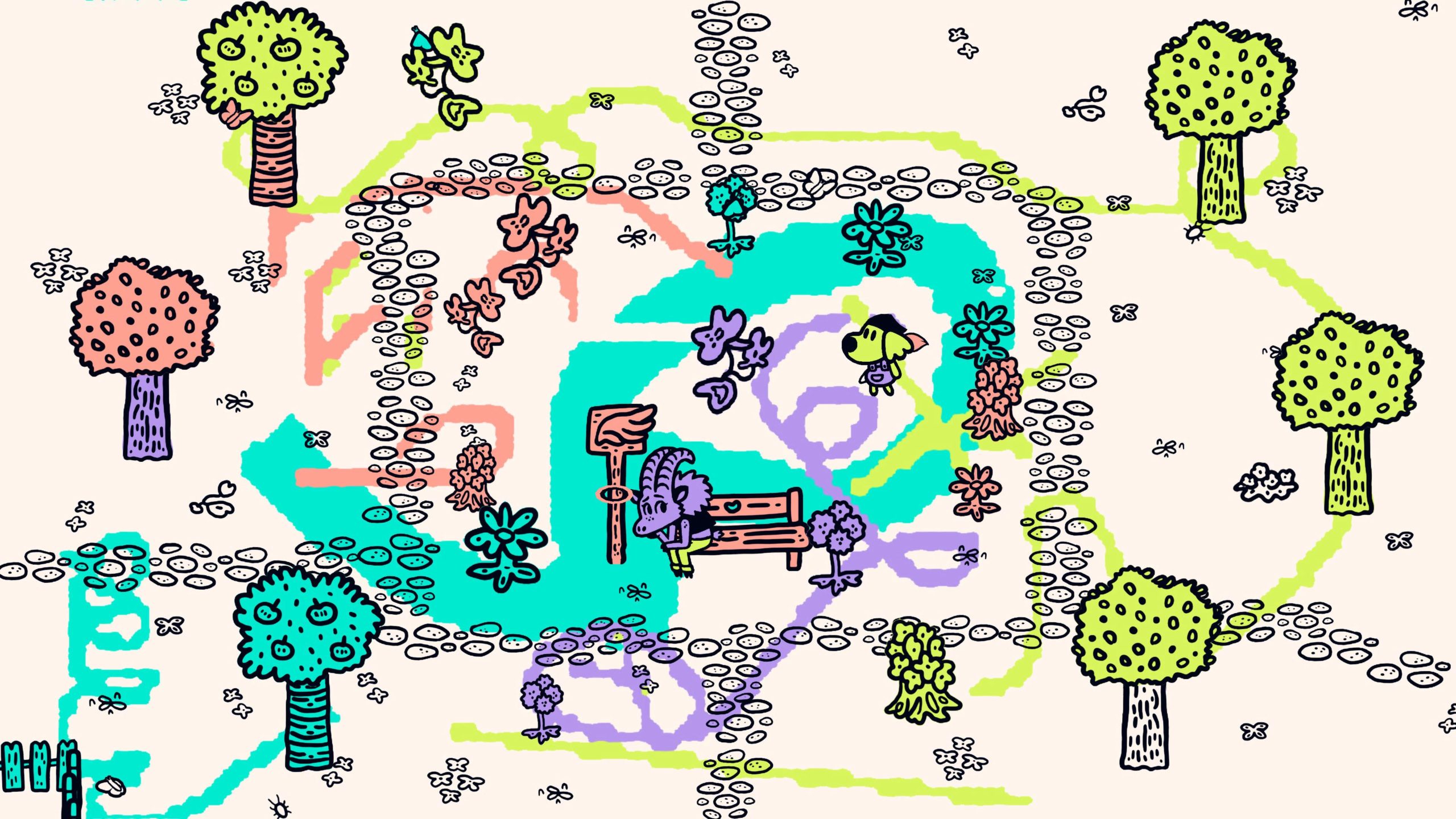
In Chicory, you play as a plucky dog character who begins the game as a janitor. This character isn’t the titular character however – the game will ask you to name your favourite food which will actually name the anthropomorphic pooch protagonist. In fact, every place and character you meet in this game is named after food or eating related terms. My canine cleaner ended up being called Pizza. Because of course they did.
In the fantasy world that this game is set, there is always one ‘wielder’. They are the ones that give this world its colour by using a magical paintbrush. This brush is passed from wielder to wielder, each of which has their own style. At the start of this game, the aforementioned Chicory is the current owner of the brush. Pizza is cleaning up the technicolor home of Chicory when something weird starts to happen and all the colour of the world vanishes. Setting out to investigate, Pizza finds the magic brush abandoned and its wielder locked away in her room, unresponsive.
So, Pizza (or whatever food name you choose) takes the brush and sets out to see if she can find out why the colour of the world has disappeared.
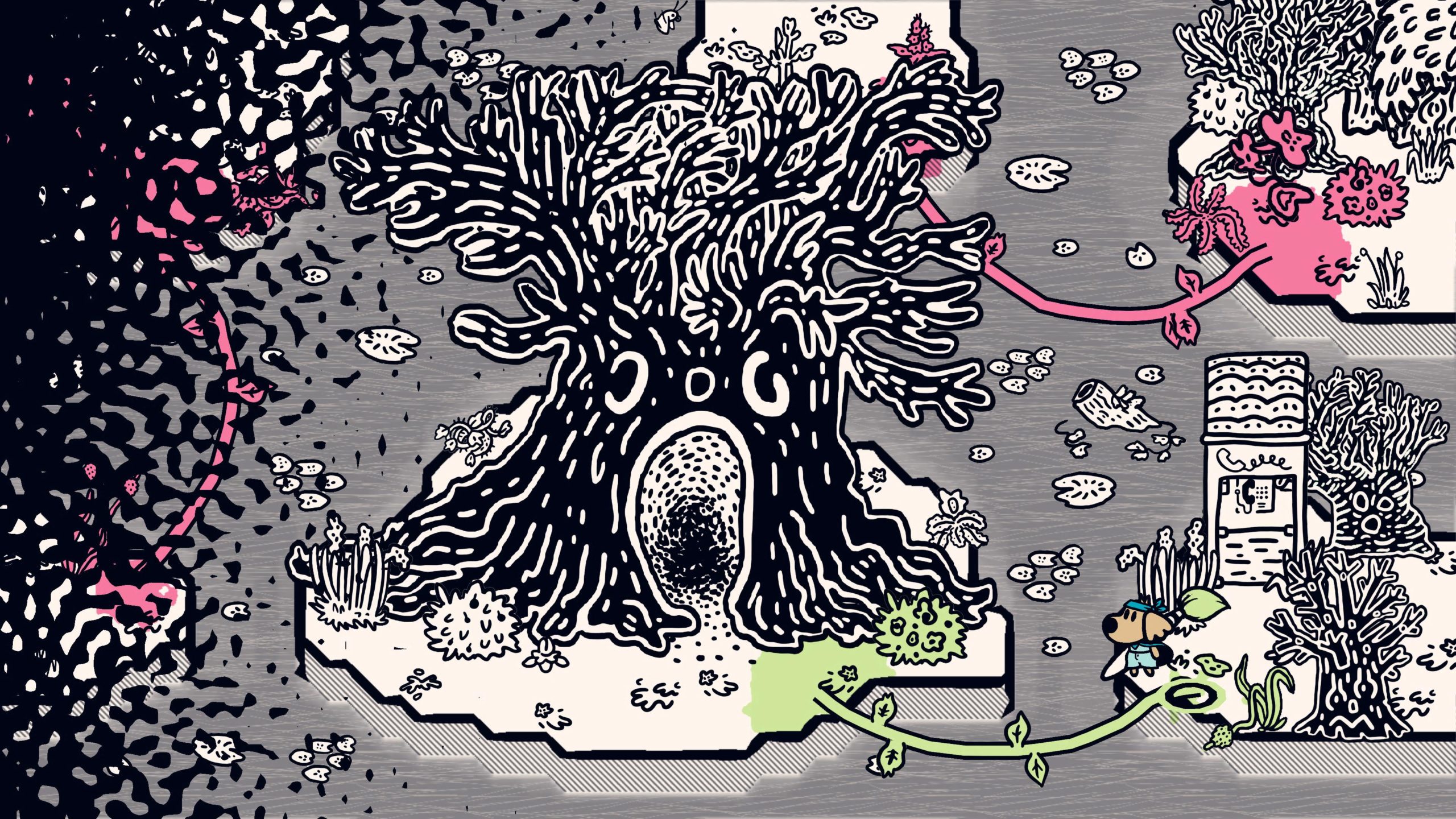
Now, I don’t really want to spoil any more of the finer story details by describing them here. Everything above happens in the game’s first five minutes. Needless to say, from here, the protagonist of Chicory goes on a pretty wild adventure but to mention what happens, even in abstract terms, would be to ruin some of the games more poignant moments. What I will say though is that this game contains a surprisingly deep, emotionally honest narrative with a cast of flawed by relatable characters. It’s beautiful at times, as the relationships between these characters grow and how they blossom as people. It’s uncomfortably real in others, touching on imposter syndrome, the effects of depression, how burdensome responsibility can be some times, dealing with failure and trying to meet the expectations placed upon you.
What’s more, I was constantly impressed by how the story in Chicory mirrored the feelings of the player. An example that I hope won’t spoil anything: Pizza (or whatever you call them), as the person currently holding the brush, gets asked a number of times to perform tasks by other characters around the world. Perceived as the new wielder, they have a responsibility to uphold. While all of these activities are relatively fun, they do show how much of a demand is put on them as a character. While the player has this important, overarching goal to restore colour to the world, these demands put upon you and distract you from your aims and this is referenced a few times in the narrative. It’s smart implementation of an exemplary script.
The game play in Chicory centres around its most unique element – the paint brush. The game world itself is presented in frames, each of which looks like the page of an untouched colouring book. These frames are all connected to one another via clear paths/edges and you can navigate the main character through them using the left stick on the DualShock controller. The right stick controls the paintbrush reticule. Using the trigger buttons you can change the colour the brush will paint (from 4 hues which are designated to that area of the game) change the size of the brush, paint and erase. By using the paintbrush by holding down L2 and moving the reticule around the screen, you can colour anything in the world – NPC’s, the floor, walls, environmental items and even the protagonist – to let your creativity go wild.
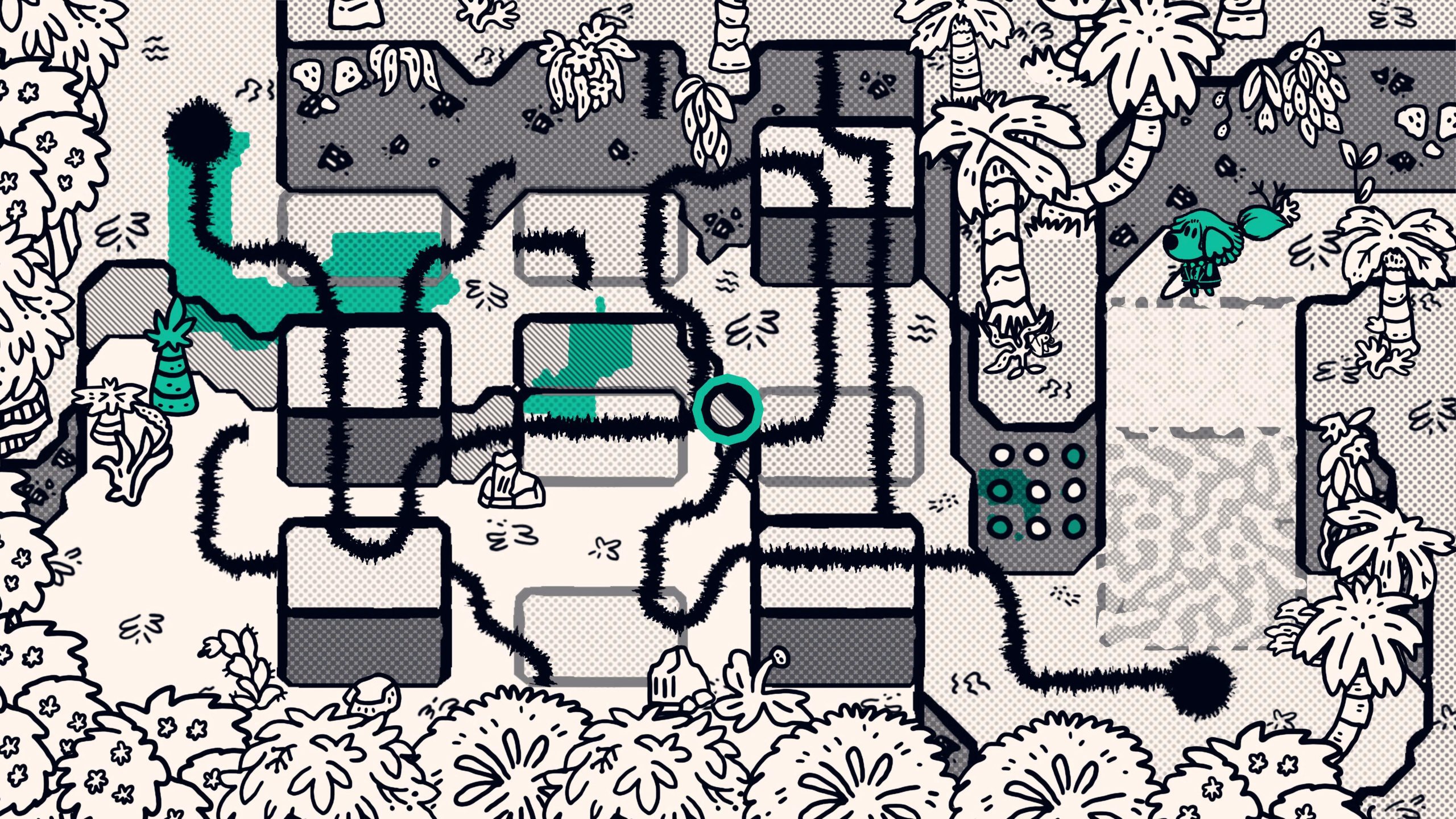
What’s most important about the paint brush however is how it influences the world as you colour it. This forms the core of all of the puzzles in Chicory. It begins with plants that shrink when painted and mushroom-like bounce pads that grown when coloured. Later there are bubbles that explode when you dab them with paint and paint that glows in the dark so you can light your way through dark passages. There are images made of dots that need to be have a pattern painted onto them – the solution to which will require some creative thinking. One section of the game stars a species of paint eating bug which have a platform on its back – you’ll need to trace lines of paint around the level to lead them around each frame. Towards the end of the game there are platforms which rise and fall depending on if buttons are painted.
Chicory features a Zelda-classic-esque progression system too. As the protagonist progresses through the game, they gain new abilities which help them reach new areas which were previously unreachable. Pizza Pooch (Hamburger Hound, Chipotle Canine or whatever else you call them) learns to jump over small gaps and swim in their paint (like Splatoon) in order to access new locations.
The difficulty curve of the puzzles is pitched neigh on perfectly. Each new puzzle element joins the web of existing ones to make the head scratchers progressively more challenging without ever being too complicated. The most difficulty puzzles in the game are those that require actions to be performed on multiple different screens in order to move forward; while the puzzles on each frame are self-contained, some have multiple entrances and exits which you’ll need to reach by doing a little backtracking.
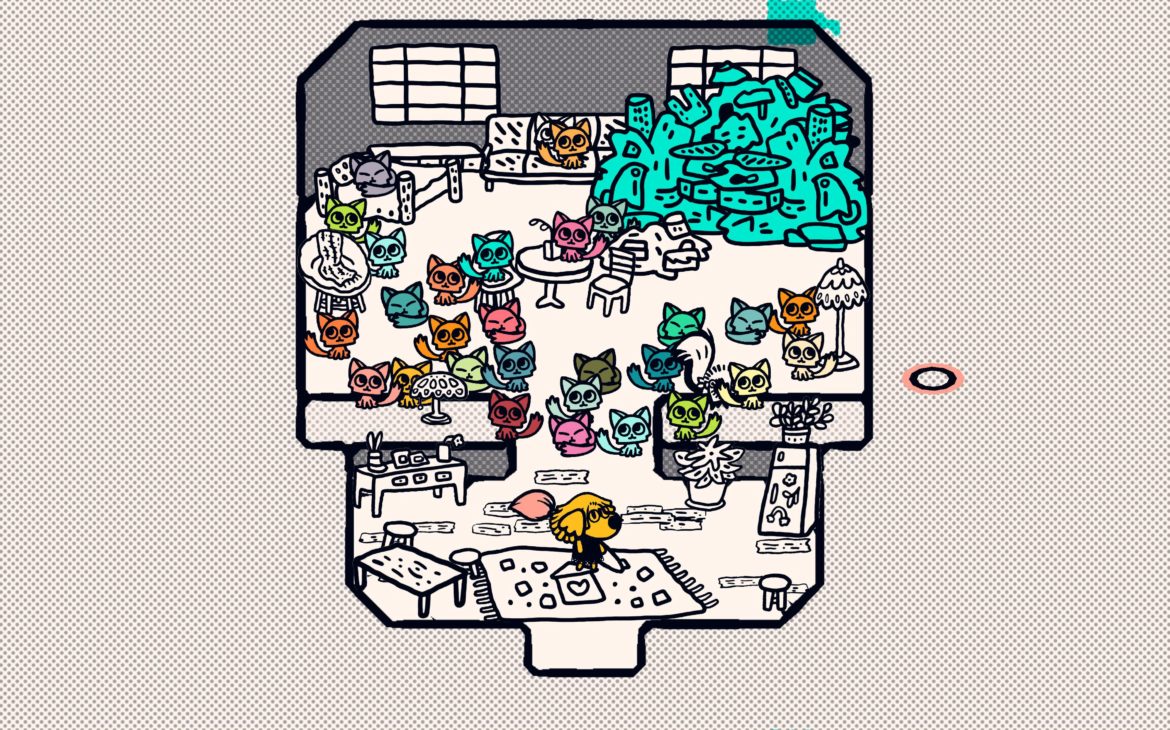
The only time the puzzles in Chicory caused me to furrow my brow was when a series of plants were introduced. The plants grow and move in directions depending on which of their leaves are painted by the brush. This became a little fiddly, especially when the protagonist was standing on them. When combined with the various different elevations of platform, which isn’t always immediately clear because of the 2D nature of the visuals, it makes for a singularly clunky section of the game in an otherwise exceptional lattice of puzzle mechanics.
Then there’s the boss battles. This is, again, an element of Chicory I don’t want to spoil as it’s tied to the narrative. What I will say though is that they’re a series of inventive, novel twists on the use of the paint brush mechanic which are constantly surprising and visually mesmerising. There are no failure conditions in Chicory – if your character takes a few hits of damage during these battles, they quickly reset at the last change of battle structure and it begins again – so it keeps the game rolling at a constant pace. You’re unlikely to get hung up on a single boss battle which stalls your progress.
One of the most stand out aspects of this game is its charm. There’s a large and diverse cast of characters to talk too – from a pair of phone obsessed teens discussing capitalism and art to the protagonists’ parents that lovingly provide hints should you call them from a pay phone – which give the world of Chicory a distinct, living personality. Each area of the game has its own colour palette which sets its tone as you paint it. There’s collectables and mini-quests, optional puzzles and secret areas which reward the lead character with new clothes to wear – seriously, Pizza ended up with the best wardrobe known to dog kind.
There are moments when Chicory asks you to flex your creative muscles too. Characters will ask you to paint things, design them a logo or make a portrait of them. As you do so, they become a part of the game world. I don’t have a creative bone in my body but the tools on offer in this game made it easy for me to have fun while making terrible, terrible artwork.
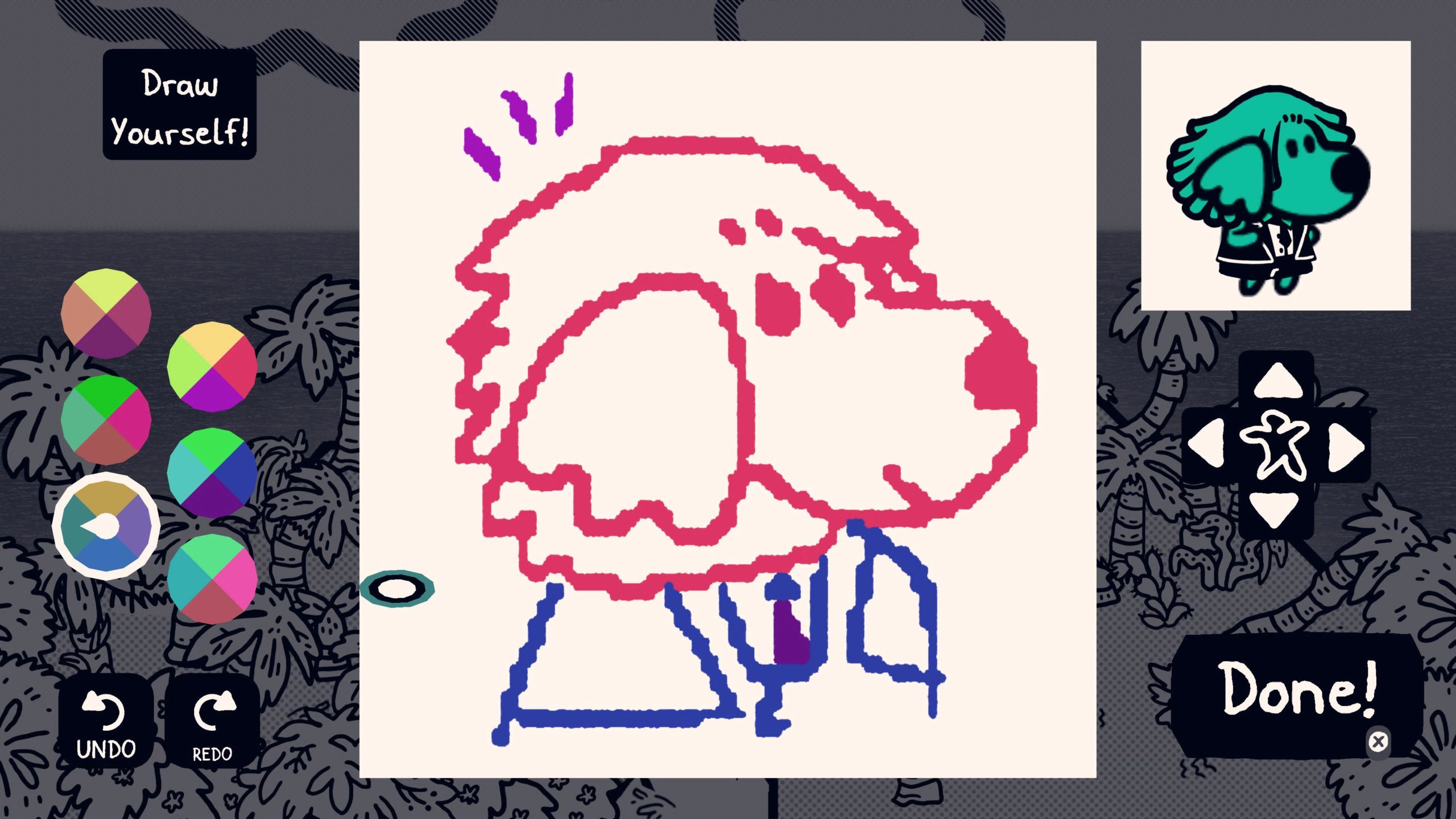
Thankfully, the art style of Chicory is sublime. Like an blank canvas that’s begging for you to paint its every surface, it offers that same therapeutic mindfulness that a colouring book does. It’s deeply satisfying to walk into an area of white with black outlines and leave it as a finished article. What really helps with this is the way that the paint brush behaves while you’re using it. When you’ve got the L2 trigger pulled, the brush won’t stray outside of the lines. Coupled with the gentle but palpable feedback from the adaptive triggers and the sound effects from the speakers on the DualSense controller, it’s really gratifying just… painting things.
This is topped off by a truly fantastic soundtrack. Whether it’s the chugging strings of the songs driving you higher into the mountains, the chirpy tones in the towns or the fast paced beats during the boss battles, the music in Chicory complements the tone of the narrative and visuals expertly. I know this is a bold statement, given the amazing music that Lena Raine has created previously, but I’m going to say it anyway – I think the music in Chicory might be Raine’s best work. It’s truly amazing.
Chicory is the kind of game that reminds me why I enjoy gaming in the first place. It takes innovative, artistically driven mechanics and makes them accessible and intuitive. It combines them with a narrative which is emotionally charged and truly engrossing. This is all topped off with a fantastic world that houses oodles of charm, a top class soundtrack and puzzle design that challenges the player while rarely becoming frustrating.

Chicory: A Colorful Tale is available now on PS5 (review platform), PS4 and PC via Steam.
Developer: Greg Lobanov / Alexis Dean-Jones / Lena Raine / Madeline Berger / A Shell in the Pit
Publisher: Finji
Disclaimer: In order to complete this review, we were provided with a promotional copy of the game. For our full review policy, please go here.
If you enjoyed this article or any more of our content, please consider our Patreon.
Make sure to follow Finger Guns on our social channels – Twitter, Facebook, Twitch, Spotify or Apple Podcasts – to keep up to date on our news, reviews and features.
